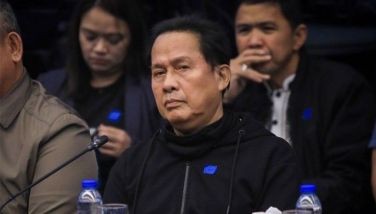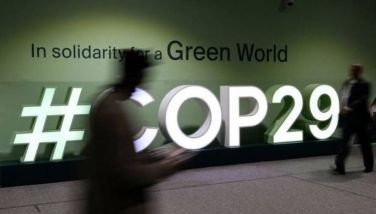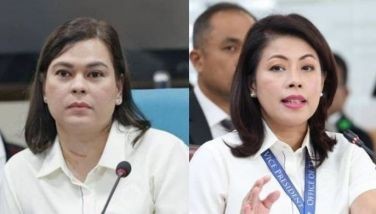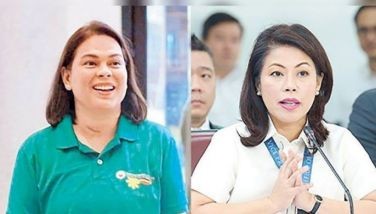Ombudsman conducting own lifestyle check
November 12, 2002 | 12:00am
The Office of the Ombudsman is quietly checking on the lifestyles of government officials to see if they are illegally amassing wealth, an official said yesterday.
"We have verbal instructions from the Ombudsman to do just that," Assistant Ombudsman Ernesto Nocos said.
Last month, President Arroyo ordered the Presidential Anti-Graft Commission (PAGC) to conduct a "lifestyle check" on top government officials — from Cabinet members to bureau directors.
Her order came after the Philippines was rated the 11th most corrupt country in a survey of 102 countries conducted by London-based Transparency International.
Nocos said they were conducting the probe on their own initiative. "The PAGC and the Ombudsman have concurrent jurisdictions on the administrative aspect," he explained.
Nocos made it clear that it was not yet investigating any specific official. "We are still on the evaluation stage," he said. "We need to study the facts carefully and see if they warrant a full-blown investigation."
In an interview with foreign correspondents in early July, US Ambassador Francis Ricciardone said the Philippines was losing out to other countries in luring foreign investors because of massive corruption in the judiciary and in the government.
The Philippines loses an estimated P21 billion a year to corruption in the procurement of government goods and services alone. About 15 percent of the cost of all government contracts is lost to corruption.
Upon assuming office in 2001, Mrs. Arroyo pledged to root out corruption, a serious problem that hounded past administrations.
In January 2001, Mrs. Arroyo’s predecessor, Joseph Estrada, was ousted in a military-backed popular protest after he was accused by an estranged drinking buddy of taking bribes from illegal gambling bosses, misusing state funds and profiting from insider trading.
Arrested last year, Estrada is now detained in a military hospital and currently on trial for plunder, a charge that carries the death penalty.
A slew of anti-graft agencies
Since the 1950s, the Philippines has seen a succession of 13 bodies created by the chief executive to fight graft. The first such agency was the Integrity Board put up by Elpidio Quirino in 1950 when he issued Executive Order 318.
Ramon Magsaysay followed suit with the Presidential Complaints and Action Commission, created through EO 1 issued in 1953. Magsaysay later replaced this with the Presidential Complaints and Action Committee through EO 19.
Carlos Garcia had his own Presidential Committee on Administration Performance Efficiency, created in 1958 through EO 306. Garcia also issued EO 378, forming the Presidential Anti-Graft Committee.
Diosdado Macapagal, the incumbent President’s late father, formed his own Presidential Anti-Graft Committee through EO 4, issued in 1962.
His successor, Ferdinand Marcos, replaced this with the Presidential Agency on Reforms and Government Operations (PARGO) in 1966 through EO 4.
This was later replaced by the Presidential Complaints Action Office. In 1967, Marcos revived the PARGO. Three years later, he issued EO 208, converting PARGO into the Complaints and Investigation Office.
The CIO continued to exist through the martial law years (1972 to 1981) even when the 1973 Constitution provided for the creation of the Tanodbayan, the predecessor of the Office of the Ombudsman, which investigates official corruption.
The current Presidential Anti-Graft Commission is a reformatted version of an agency formed by Fidel Ramos.
According to Salvador Carlota, professor of law at the University of the Philippines, anti-graft agencies "were doomed to failure at the very moment of their creation primarily because they were not free from political pressures."
"There was, to begin with, no leeway for political independence," Carlota wrote in 1990 in the Philippine Law Journal , the country’s prestigious law journal, because the agencies – being creations of the Chief Executive – remained under the President’s control.
"We have verbal instructions from the Ombudsman to do just that," Assistant Ombudsman Ernesto Nocos said.
Last month, President Arroyo ordered the Presidential Anti-Graft Commission (PAGC) to conduct a "lifestyle check" on top government officials — from Cabinet members to bureau directors.
Her order came after the Philippines was rated the 11th most corrupt country in a survey of 102 countries conducted by London-based Transparency International.
Nocos said they were conducting the probe on their own initiative. "The PAGC and the Ombudsman have concurrent jurisdictions on the administrative aspect," he explained.
Nocos made it clear that it was not yet investigating any specific official. "We are still on the evaluation stage," he said. "We need to study the facts carefully and see if they warrant a full-blown investigation."
In an interview with foreign correspondents in early July, US Ambassador Francis Ricciardone said the Philippines was losing out to other countries in luring foreign investors because of massive corruption in the judiciary and in the government.
The Philippines loses an estimated P21 billion a year to corruption in the procurement of government goods and services alone. About 15 percent of the cost of all government contracts is lost to corruption.
Upon assuming office in 2001, Mrs. Arroyo pledged to root out corruption, a serious problem that hounded past administrations.
In January 2001, Mrs. Arroyo’s predecessor, Joseph Estrada, was ousted in a military-backed popular protest after he was accused by an estranged drinking buddy of taking bribes from illegal gambling bosses, misusing state funds and profiting from insider trading.
Arrested last year, Estrada is now detained in a military hospital and currently on trial for plunder, a charge that carries the death penalty.
A slew of anti-graft agencies
Since the 1950s, the Philippines has seen a succession of 13 bodies created by the chief executive to fight graft. The first such agency was the Integrity Board put up by Elpidio Quirino in 1950 when he issued Executive Order 318.
Ramon Magsaysay followed suit with the Presidential Complaints and Action Commission, created through EO 1 issued in 1953. Magsaysay later replaced this with the Presidential Complaints and Action Committee through EO 19.
Carlos Garcia had his own Presidential Committee on Administration Performance Efficiency, created in 1958 through EO 306. Garcia also issued EO 378, forming the Presidential Anti-Graft Committee.
Diosdado Macapagal, the incumbent President’s late father, formed his own Presidential Anti-Graft Committee through EO 4, issued in 1962.
His successor, Ferdinand Marcos, replaced this with the Presidential Agency on Reforms and Government Operations (PARGO) in 1966 through EO 4.
This was later replaced by the Presidential Complaints Action Office. In 1967, Marcos revived the PARGO. Three years later, he issued EO 208, converting PARGO into the Complaints and Investigation Office.
The CIO continued to exist through the martial law years (1972 to 1981) even when the 1973 Constitution provided for the creation of the Tanodbayan, the predecessor of the Office of the Ombudsman, which investigates official corruption.
The current Presidential Anti-Graft Commission is a reformatted version of an agency formed by Fidel Ramos.
According to Salvador Carlota, professor of law at the University of the Philippines, anti-graft agencies "were doomed to failure at the very moment of their creation primarily because they were not free from political pressures."
"There was, to begin with, no leeway for political independence," Carlota wrote in 1990 in the Philippine Law Journal , the country’s prestigious law journal, because the agencies – being creations of the Chief Executive – remained under the President’s control.
BrandSpace Articles
<
>
- Latest
- Trending
Trending
Latest
Trending
Latest
Recommended





























